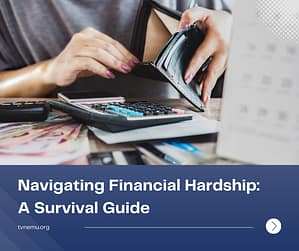
Financial hardship can strike anyone, at any time, often without warning. Whether it’s due to a global economic downturn, personal health issues, or unexpected job loss, the stress and uncertainty can be overwhelming. However, with the right strategies and mindset, navigating through financial crises is possible. This guide provides practical advice on managing financial crises, including negotiating with creditors and seeking financial assistance, with the aim to empower you with knowledge and tools for overcoming these challenges.
Recognizing Financial Hardship
The first step in navigating financial hardship is recognizing the signs early. These can include struggling to pay bills on time, using credit cards for everyday expenses, or dipping into savings to make ends meet. Acknowledging the situation allows you to take proactive steps towards resolution.
Creating a Crisis Budget
When facing financial hardship, revisiting your budget is crucial. A crisis budget focuses on minimizing expenses to essentials only. This means cutting non-essential spending and finding ways to reduce bills. Tools and apps reviewed in 10 Budgeting Apps: Finding the Best for You can help streamline this process, making it easier to adjust your spending in real-time.
Seeking Financial Assistance
Don’t hesitate to seek financial assistance. Many governments and non-profit organizations offer programs designed to support individuals during economic downturns. This might include unemployment benefits, food assistance programs, or temporary relief for utility bills. Applying for these programs can provide a lifeline during times of financial distress.
Strategies for Dealing with Debt
One of the most daunting aspects of financial hardship is managing debt. However, there are strategies that can help reduce the burden and avoid the negative impacts on your credit score.
Negotiating with Creditors
Open communication with your creditors is vital. Many are willing to work with you to develop a more manageable repayment plan. This might include lowering interest rates, waiving fees, or temporarily pausing payments. Remember, it’s in the creditor’s interest to help you stay afloat so you can continue to make payments in the long term.
Debt Management and Reduction Strategies
Effective debt management can prevent financial hardship from spiraling out of control. Consider strategies such as consolidating debts to lower interest rates or following a debt snowball or avalanche method for repayment. For more detailed strategies, Effective Debt Reduction Strategies That Work offers a comprehensive look at managing and overcoming debt.
Long-Term Financial Recovery
Recovering from financial hardship doesn’t happen overnight. It requires a long-term commitment to financial health and stability.
Rebuilding Your Emergency Fund
Once you’ve stabilized your immediate financial situation, focus on rebuilding your emergency fund. Even small, regular contributions can build a financial cushion over time, offering protection against future crises. For guidance on how to effectively build this fund, visit How to Create an Emergency Fund: Steps to Financial Security.
Investing in Your Financial Education
Knowledge is power, especially when it comes to financial management. Investing time in learning about personal finance, credit management, and investment strategies can fortify your financial resilience. Resources like The Ultimate Guide to Personal Finance Management can provide a wealth of information to help you navigate future financial challenges more effectively.
Conclusion
Navigating financial hardship is undoubtedly challenging, but it’s not insurmountable. By taking decisive action, seeking assistance, and implementing strategic financial management practices, you can emerge from these crises stronger and more financially savvy. Remember, the journey to financial recovery is a marathon, not a sprint. With perseverance and the right resources, you can rebuild a stable and secure financial future.